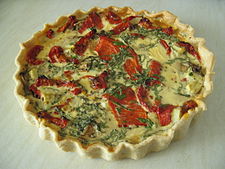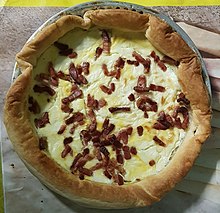Quiche
 A typical quiche | |
| Type | Tart |
|---|---|
| Place of origin | |
| Main ingredients | Pastry case filled with egg and cheese, meat, seafood, or vegetables |
Quiche (/ˈkiːʃ/ KEESH) is a French tart consisting of a pastry crust filled with savoury custard and pieces of cheese, meat, seafood or vegetables. A well-known variant is quiche lorraine, which includes lardons or bacon. Quiche may be served hot, warm or cold.
Overview[edit]
Etymology[edit]
The word is first attested in French in 1805, and in 1605 in Lorrain patois. The first English usage — "quiche lorraine" — was recorded in 1925. The further etymology is uncertain, but it may be related to the German Kuchen meaning "cake" or "tart".[1]
History[edit]

Quiche is a French dish originating from the eastern part of the country. It may derive from an older preparation called féouse[2] typical in the city of Nancy in the 16th century. The early versions of quiche were made of bread dough but today shortcrust and puff pastry are used.[3] In 1586, They were served at a dinner for Charles III, Duke of Lorraine[4]. Before that, recipes for eggs and cream baked in pastry containing meat, fish and fruit are referred to as Crustardes of flesh and Crustade in the 14th-century The Forme of Cury.[5] Since the Middle Ages, there have been local preparations in Central Europe, from the east of France to Austria, that resemble quiche[6].
The American writer and cookery teacher James Peterson recorded first encountering quiche in the late 1960s and being "convinced it was the most sophisticated and delicious thing [he had] ever tasted". He wrote that, by the 1980s, American quiches had begun to include ingredients he found "bizarre and unpleasant", such as broccoli,[n 1] and that he regarded Bruce Feirstein's satirical book Real Men Don't Eat Quiche (1982) as the "final humiliation" of the dish, such that "[a] rugged and honest country dish had become a symbol of effete snobbery".[7]
Varieties[edit]
A quiche usually has a pastry crust and a filling of eggs and milk and/or cream. It may be made with vegetables, meat or seafood, and be served hot, warm or cold.[8][9] Types of quiches include:
| Name | Main ingredients | Ref |
|---|---|---|
| Quiche au Camembert | Camembert cheese, cream, eggs | [10] |
| Quiche aux champignons | Mushrooms, cream, eggs | [11] |
| Quiche aux endives | Chicory, cream, eggs, cheese | [12] |
| Quiche aux épinards | Spinach, cream, eggs | [11] |
| Quiche au fromage de Gruyère | Gruyère cheese, cream, eggs, bacon | [13] |
| Quiche aux fromage blanc | Cream cheese, cream, eggs, bacon | [14] |
| Quiche aux fruits de mer | Shrimp, crab or lobster, cream, eggs | [15] |
| Quiche aux oignons | Onions, cream, eggs, cheese | [16] |
| Quiche aux poireaux | Leeks, cream, eggs, cheese | [12] |
| Quiche au Roquefort | Roquefort cheese, cream, eggs | [10] |
| Quiche comtoise | Comté cheese, cream, eggs, smoked bacon | [17] |
| Quiche lorraine | Cream, eggs, bacon[n 2] | [13] |
| Quiche niçoise, à la tomate | Anchovies, olives, tomatoes, eggs, Parmesan cheese | [10] |
In her French Country Cooking (1951), Elizabeth David gives a recipe for a quiche aux pommes de terre, in which the case is made not from shortcrust pastry but from mashed potato, flour and butter; the filling is cream, Gruyère and garlic.[18]
Gallery[edit]
See also[edit]
Notes[edit]
- ^ Peterson's noting his aversion to broccoli echoed earlier remarks by former President George H. W. Bush, who too notably did not like the vegetable.
- ^ Some recipes add cheese, but the traditional Lorrainian version does not.[14]
References[edit]
- ^ "quiche". Oxford English Dictionary. OUP. 2015. Retrieved 4 February 2016.
- "Quiche", Centre Nationale de Ressources Textuelles et Lexicales. Accessed 12 February 2015. This source also notes the first reference to 1805, in J.-J. Lionnois, Hist. des villes vieille et neuve de Nancy..., Nancy, t. 1, p. 80 - ^ Hamlyn (2 August 2018). New Larousse Gastronomique. Octopus. ISBN 978-0-600-63587-1.
- ^ Damien Pignolet (13 June 2019). "How to make a goat's cheese and herb quiche". Gourmet Traveller.
- ^ Renauld, Jules Auteur du texte (1875). Les hostelains et taverniers de Nancy : essai sur les moeurs épulaires de la Lorraine / par Jules Renauld,...
- ^ Hieatt, Constance; Butler, Sharon (1985). Curye on Inglysch: English culinary manuscripts of the fourteenth century (including the forme of cury. SS. Vol. 8. London: EETS.
- ^ Germershausen, Christian Friedrich (1782). Die Hausmutter in allen ihren Geschäfften (in German). Junius.
- ^ Peterson, p. 153
- ^ David (2008), pp. 18 and 187
- ^ Beck et al, p. 153
- ^ a b c Beck et al, p. 155
- ^ a b Beck et al, p. 160
- ^ a b Beck et al, p. 159
- ^ a b Beck et al, p. 154
- ^ a b David (2008), p. 187
- ^ Beck et al, p. 156
- ^ Beck et al, p. 157
- ^ Montagné, p. 430
- ^ David (1999), p. 285
Sources[edit]
- Beck, Simone; Louisette Bertholle; Julia Child (2012) [1961]. Mastering the Art of French Cooking, Volume One. London: Particular. ISBN 978-0-241-95339-6.
- David, Elizabeth (1999) [1950, 1951, 1955]. Elizabeth David Classics – Mediterranean Food; French Country Cooking; Summer Food (second ed.). London: Grub Street. ISBN 1-902304-27-6.
- David, Elizabeth (2008) [1960]. French Provincial Cooking. London: Folio Society. OCLC 809349711.
- Montagné, Prosper (1976). Larousse gastronomique. London: Hamlyn. OCLC 1285641881.
- Peterson, James (2002). Glorious French Food: A Fresh Approach to the Classics. New York: Wiley. ISBN 978-0-471-44276-9.




